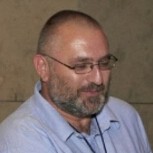
Professor of Photonic Engineering
Academic Division: Electrical Engineering
Telephone: +44 1223 7 48353
Email: tdw@eng.cam.ac.uk
Research interests
Prof. Wilkinson has had a long term research interest into the applications of liquid crystal (LC) devices, holograms and related photonic applications. One breakthrough made recently was in algorithms which lead to the commercialisation of holographic projectors. This has lead to a highly successful company started by 3 of my students which won $26M USD. Commercial development of holographic systems is still on-going and I am looking into the design of next generation LC devices suitable for 3D holographic displays. The use of holograms has also been used for telecoms to demonstrate modal control and full mode characterisation in multimode fibres. Holograms can also be use to enhance amd control high powered lasers in additive manufacturing processes. Core to my research has been liquid crystal device fabrication and the search for the optimal materials for different applications. One of the holy grails that has eluded us so far is the fast elector-optical effect suitable to modulate the phase of the light at rates < 1mSec. Recent research highlights:
- holographically controlled modal dispersion and MIMO using mode group multiplexing
- The quest for fast multilevel phase modulators
- Reconfigurable microlenses based on carbon nanotube and graphene electrodes in LCs
- Growth of patterned CNT arrays on quartz and with < 500nm spacings
- An integral imaging 3D microscope with LC/CNT tuneable lenses
- CNT based metamaterials, Fresnel optics and holograms
- Fabrication of fully RGB tuneable and printable LC lasers
- Enhanced holographic projection using new computer generated hologram algorithms.
- Enhanced holographic head up displays
My research has pioneered hybrid LC/CNT (carbon nanotube) technology, including design and fabrication of plasmonic optical filters, waveguides, resonators, gyroids and super-resolution lenses. We have also demonstrated that these structures can be made reconfigurable using LC materials. More recently, new devices and electro-optics have been demonstrated using graphene and LC/graphene materials.
Strategic themes
Energy, transport and urban infrastructure
The ability to control light is an important feature in both energy conservation and the development of urban infrastructure. New materials and photonics are now starting to have a major impact in these area.
Manufacturing, design and materials
My group has several collaborations lead by industrial interest across many photonic applications from Telecommunications to Displays. Recent projects include Samsung, Selex ES, BAE Systems, RSoft
Research projects
- EPSRC grant ‘Exploiting the bandwidth potential of multi-mode fibres’ (COMIMO)
- EPSRC grant CVD enabled Graphene Technology and Devices (GRAPHTED)
- EPSRC grant 'High speed phase modulating liquid crystals'
- EPSRC grant 'Holographic additive manufacturing'
Teaching activity
- ENG IA ‘Electromagnetics - the physical principles of electronics’ - how physics such as Gauss and Ampere lead to fundamental electrical engineering principles of capacitance and inductance for use in circuits.
- ENG 1A 'Analysis of Circuits and Devices' - basic principles of electrical engineering and circuit theory that leads the design and understanding of both passive and active circuits.
- ENG 1A 'Integrated electronics project (IEP)' - A series of hands on experiments using a take home kit of components that go from basic circuits through to a final design project.
- ENG IIB, 4B11 ‘Photonic Systems’ Fourier optics, holography and liquid crystals, including free space optics, optical materials and adaptive optics.
Research opportunities
We are always looking for new PhD applicants in any of the areas you see on the CMMPE web pages.
